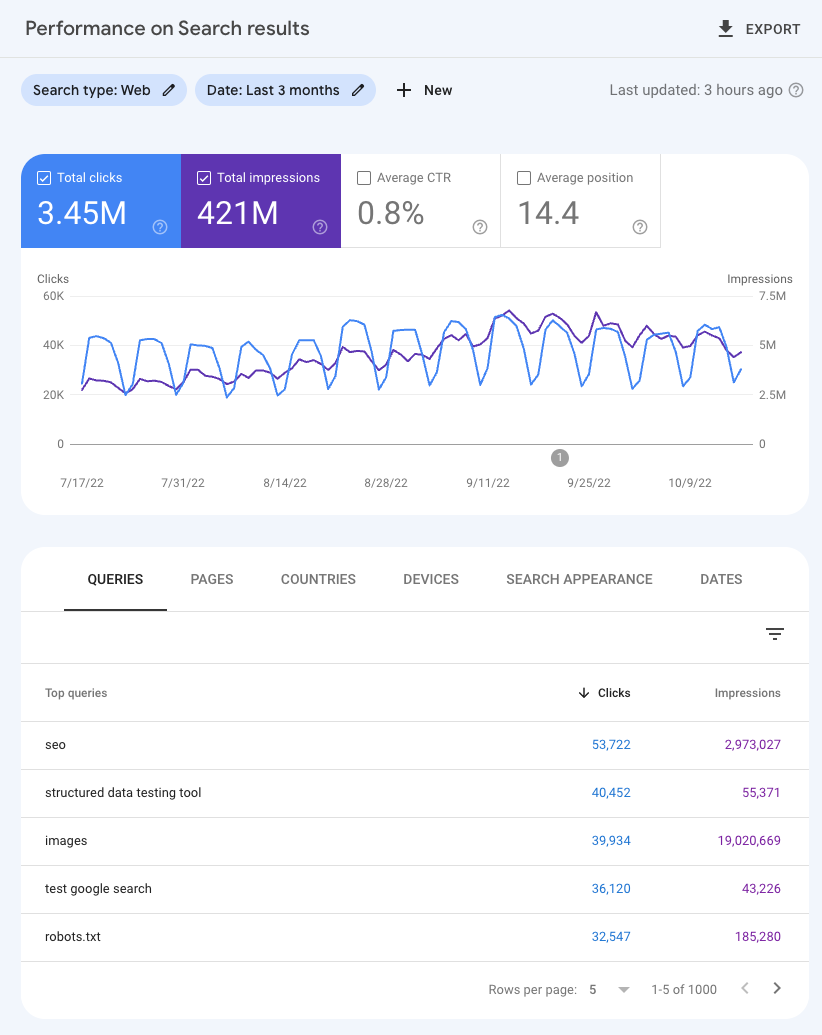2022 年 10 月 19 日(水曜日)
Google 検索のパフォーマンス データは、パフォーマンス レポートと Search Analytics API を通じて最も広く利用されているデータです。このブログ投稿では、プライバシー フィルタリングや、待ち時間、ストレージ、処理リソースに関連するその他の制限事項を含め、利用可能なデータと Google がそれを処理する方法について、詳しく説明します。こうしたシステムの仕組みが気になったことはありませんか?詳しく見てみましょう。
Search Console を初めて利用する場合は、パフォーマンス レポートの概要に関するページをご覧ください。
検索パフォーマンスの基本
検索パフォーマンス レポートには、検索トラフィックの経時的な変化を示す 4 つの指標が含まれています。各指標の計算方法について説明している記事の概要を以下に記載します。
- クリック数: ユーザーが Google 検索の検索結果をクリックしてプロパティに移動した回数。
- 表示回数: ユーザーが Google 検索の検索結果でプロパティを表示した回数。
- CTR(クリック率): クリック数を表示回数で割った値。
- 掲載順位: URL、クエリ、またはウェブサイトの一般的な検索結果の平均掲載順位。
こうした指標はそれぞれ、さまざまなディメンションに関して分析できます。ウェブサイトへのトラフィック増加の要因となった各クエリ、ページ、国、デバイス、検索での見え方を確認できます。
検索のパフォーマンス データには、プロダクト インターフェース、Search Analytics API、Looker Studio コネクタ、スプレッドシート(インターフェースから手動でダウンロードする必要があります)など、さまざまな方法でアクセスできます。
プロダクト インターフェースを使用している場合は、以下の画像に示すように、フィルタまたはグラフの下に表示されているディメンション テーブルを介してディメンションを使用できます。

このデータを利用して、ウェブサイトの視認性を高め、最終的に Google からのトラフィック増加を実現する方法を見つけることができます。実施可能な分析の種類のサンプルについては、こちらのサンプル最適化グラフをご覧ください。
データのフィルタリングと制限
レポート インターフェースのデータとエクスポートされたデータの両方が、異なる方法で集計され、フィルタされます。データの主な制限事項は 2 つあります。プライバシー フィルタリングと、1 日あたりのデータの行数制限です。
プライバシー フィルタリング
一部のクエリ(匿名化されたクエリ)は、クエリを行ったユーザーのプライバシーを保護するため、Search Console のデータに含まれません。
匿名化されたクエリは、2~3 か月間に数十人未満のユーザーが発行したクエリです。プライバシー保護のため、実際の検索語句は検索のパフォーマンス データに表示されません。そのため、このようなクエリを匿名化されたクエリと呼んでいます。実際の匿名化されたクエリは常にテーブルから除外されますが、クエリでフィルタしない限りグラフの合計に含まれます。
具体例を見てみましょう。この図はプライバシー フィルタリングのみを考慮したものです。1 日のデータの行数制限については次のセクションで説明しますが、ここでも重要な役割を果たします。この点について詳しく説明します。以下の表に、ウェブサイトへのクエリに関するすべてのトラフィックについて、匿名化されていないクエリに関連するトラフィックを項目別に示します。一般的なウェブサイトでは、通常 4 つを超える項目が匿名化されていないクエリとなりますが、この例では項目を 4 つに絞っています。
| クエリ | クリック数 |
| 古典文学 | 150 |
| 詩 | 125 |
| サイエンス フィクション | 100 |
| ノンフィクション | 75 |
| 各項目のクエリの合計 | 450 |
| 合計 | 550 |
各項目のクエリを合計すると、グラフに示すように、クリック数は 450 回です。また、サイト全体のクリック数は 550 回です。この数値は、各項目のすべてのクリック数と、一覧に表示されていない匿名化されたクエリに関連するクリック数の両方を含むため、大きな値になります。
実際には、Search Console のレポートを使用する場合、主に次の 2 つのケースでこの種の不一致が見られます。
- 匿名化されたクエリに関する行は、レポート テーブルまたは API(ここでは説明のために追加)には存在しないため、すべての行のクリック数を合計すると、グラフの合計クリック数と一致しません。たとえば、この場合は行の合計クリック数は 450 ですが、グラフの合計クリック数は 550 です。
- フィルタが適用されるたびに匿名化されたクエリが省略されるため、グラフの合計クリック数と、
some_stringを含むクリック数とsome_stringを含まないクリック数の合計を比較した場合、差異が生じます。この例では、フィルタを使用して「フィクション」という単語を含むクエリのみにしたときのクリック数は 175、反対に「フィクション」という単語を含むクエリを除外したときのクリック数は 275 で、合計 450 になります。一方、グラフの合計クリック数は 550 と表示されます。
1 日あたりのデータの行数制限
待ち時間、ストレージ、処理リソースなどに関連する制限により、Search Console では表示またはエクスポートできるデータ量に制限があります。この制限は、Search Console の大部分のプロパティには影響しません。ごく一部の非常に大規模なウェブサイトは影響を受ける可能性がありますが、そのような場合でも、残りのデータはデータの代表サンプルを作成するために十分な大きさであると考えられます。
Search Console のユーザー インターフェースでエクスポートできるデータは最大で 1,000 行です。現在、Search Analytics API(および Looker Studio コネクタ)を通じてエクスポートされるデータの上限は、サイトごと、検索タイプごとに 1 日あたり 50,000 行です。これに達しない場合もあります。API が返すデフォルトは 1,000 行ですが、rowLimit を使用して 25,000 行まで増やせます。startRow を使用すると、ページ分けをして 25,001~50,000 行まで増やせます。利用可能なデータの取得方法に関するガイドをご覧ください。
国、デバイス、検索での見え方など、クエリまたは URL ディメンションを伴わないリクエストの場合、Search Console はすべてのデータを表示し、エクスポートします。
リソースとフィードバック
このテーマの詳細については、パフォーマンスに関するドキュメントをご覧ください。利用可能なデータ、パフォーマンス レポートの使用方法、グラフで生じるデータの不一致について、詳しく記載されています。
ご不明な点や気になる点がございましたら、Google 検索セントラル コミュニティまたは Twitter でお問い合わせください。
